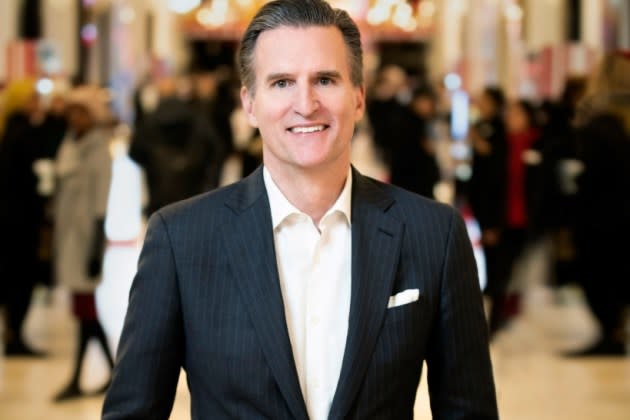Macy’s Jeff Gennette Sets Retirement Date; Tony Spring Moving Up

Jeff Gennette, the 61-year-old chairman and chief executive officer of Macy’s Inc. and a 40-year veteran of the company, will retire in February, triggering a string of top-level management changes.
Tony Spring, the 58-year-old chairman and CEO of Bloomingdale’s, has become Macy’s Inc.’s president and will become the group’s CEO upon Gennette’s retirement next year. Spring has also joined the Macy’s Inc. board.
More from WWD
Retail as Theater: A Look Back at Bloomingdale's In-Store Events
Bloomingdale's On Screen: Movies and Television the Store Has Collaborated With
A search is underway for the next CEO of Bloomingdale’s.
UPDATE: Pondering the Future of Macy’s Amid Leadership Changes
As Macy’s president Spring will be responsible for the corporation’s digital, customer, merchandising and brand teams, while overseeing the Bloomingdale’s and Bluemercury divisions. The role of president has been vacant since Hal Lawton left in December 2019 to become president and CEO of Tractor Supply.
In another key change, Macy’s chief financial officer Adrian Mitchell is taking on the additional role of chief operating officer. As CFO and chief operating officer, Mitchell will lead the store operations, technology and supply chain teams while continuing with his finance and real estate responsibilities.

In its statement Wednesday morning, Macy’s indicated that Gennette will be working alongside Spring and Mitchell until February to “ensure a smooth transition.”
The change in command is surprising considering Gennette is a few years younger than when most CEOs opt for retirement. While Macy’s most recent financial results haven’t been stellar, Gennette, widely respected for his leadership qualities and showmanship, is credited with successfully navigating Macy’s through a profusion of challenges including the pandemic, inflation, recession worries, the rise of Amazon and fast-moving shifts in consumer shopping behaviors, as well as pressure at times from activist investors.
Significantly, Gennette and his team deserve credit for something that’s hard to measure — changing industry perceptions of the $24.4 billion Macy’s Inc. for the better. It’s a big accomplishment considering all the company has been through, and the cacophony from pundits preaching the death of the department store.
RELATED: Macy’s Inc. Issues Progress Report on Corporate Citizenship
Gennette told WWD in a telephone interview that choosing his successor was a thorough process, examining both internal and external candidates, and that he’s “very excited” about working closely with Spring and Mitchell through the transition period, which is a long one. Sometimes transition periods can be strained, with the CEO-in-waiting eager to make his mark sooner rather than later. However, Gennette and Spring are said to have a good working relationship. On Wednesday, Gennette characterized Spring as “a great innovator, brand builder, a great developer of talent and with storytelling skills and deep partnerships in the vendor community.”
Spring’s ascension is hardly surprising. Aside from leading Bloomingdale’s and getting good results there, he’s been active across the Macy’s portfolio, as a member of the Macy’s executive leadership team and been involved with the repositioning of the Bluemercury division, and transforming Macy’s.
Spring was not available to discuss the changes, though in a statement, he said, “Having worked closely throughout our transformation, I see tremendous opportunity to build upon the storied reputation of each of our nameplates.”

The Bloomingdale’s division has been getting higher grades from shoppers than other department stores, primarily for quality luxury and contemporary offerings, crisp displays and an energized shopping experience abetted by associations with pop culture.
Spring has spent his entire career at Bloomingdale’s. He’s been chairman and CEO there since February 2014. He joined the store in 1987 as an executive trainee in the White Plains, New York, store. Over the next eight years he assumed positions of increasing responsibility in home furnishings, rising to senior vice president. In 1997, he was named senior vice president for marketing. A year later, he was promoted to executive vice president, and in 2003 added bloomingdales.com, Bloomingdale’s by Mail and restaurants to his responsibilities. In 2004, Spring was named senior executive vice president, and in 2008 was promoted to president and chief operating officer.
Mitchell has been Macy’s CFO since November 2020. Earlier, he was a managing director and partner in the digital and consumer practice of the Boston Consulting Group, advising retailers. He also served as CEO of home furnishings retailer Arhaus LLC, and held executive roles at Crate & Barrel.
Gennette credited Mitchell with having “deep strategic expertise and strong financial discipline” and for being “one of the best hires I ever made.”
RELATED: Denise Magid Becomes Bloomingdale’s First Chief Merchant
At Bloomingdale’s last week, Denise Magid was promoted to chief merchant. There has been speculation that she is being groomed for a bigger role within Macy’s Inc. though Gennette said she is not in the running to be the next Bloomingdale’s CEO.
A seasoned merchant, Magid was most recently executive vice president and general merchandise manager for ready-to-wear, center core, concessions and Bloomingdale’s outlets. Magid made retail history last week by becoming the first to hold the title of chief merchant at the 150-year-old Bloomingdale’s. Previous CEOs, including Michael Gould and the late Marvin Traub, were de facto chief merchants, even if they didn’t have that title, because the general merchandise managers reported directly to them.

Asked why he made the decision to disclose his retirement plans at this time, Gennette replied: “Macy’s Inc. is in really good shape. If we talk about where we were into the pandemic to where we are now, Macy’s came out in 2022 in much better financial shape, with much better operational agility, and very hungry to serve the customer. We are able to quickly pivot to where the customer is going. We have set up a series of growth vectors. We are deeply committed to going back to low-single-digit topside growth, and a low double-digit profit profile.”
Gennette has been instrumental is changing Macy’s image from being derided as a slow-moving, overstored retail dinosaur to a nimbler retailer regaining relevance. The balance sheet under Gennette has been strengthened, yet recent results haven’t been strong. Top- and bottom-line declines were reported for the fourth quarter, and further sales declines are projected for this year, but are expected to turn positive in 2024. In 2022, Macy’s was up against tough comparisons from 2021 and the headwinds of inflation, leading to steeper markdowns and lower margins.
During his tenure leading Macy’s, Gennette remade much of Macy’s senior leadership, recruiting Mitchell and five other direct reports from outside the company, among others. He has also led headcount consolidations — 2,000 positions were cut in 2020 and dot-com headquarters in San Francisco and corporate offices in Cincinnati were closed. Eighty department store closings happened, including many former May Co. stores, while resources were directed to beef up the top 100 or so locations. Macy’s bought May Co. in 2005, well before Gennette became CEO.
In 2020, Gennette introduced Macy’s Polaris strategy, a three-year plan centered on expanding assortments; accelerating digital growth; closing stores; opening smaller-scale off-mall stores; boosting certain private brands into billion-dollar businesses; enhancing personalization and the loyalty program, and reducing costs.
RELATED: Macy’s ‘Polaris’ Reinvention Strategy: It’s About Time
In an interview last fall, Gennette told WWD, “Our transformation really started two-and-a-half years ago, February 2020, at our investor day when we launched the Polaris strategy, and then the pandemic happened a month later. But Polaris has turned out to be this durable strategy that’s really helped to differentiate our business. Today we are just stronger, more agile, definitely financially healthier than before the pandemic. And we are super focused on long-term, sustainable profitable growth.”
Gennette got Macy’s Inc. to adopt new formats for generating revenue, including the Bloomie’s and Market by Macy’s specialty formats, and put the company on a course to gradually become less dependent on traditional department stores, which still represent the bulk of the business.
Gennette has led a cultural shift in Macy’s buying to a “net cost model” that began three years ago. It involves purchasing merchandise up front at lower costs and reducing markdown allowances. “The buying is more conservative and there’s built-in liquidity to respond quicker” to trends, categories and brands that consumers are shopping.
“We can respond to what’s trending within a week,” Gennette said in a recent interview with WWD. “It was an adjustment and I’m not saying it hasn’t happened without some pain. But we have deep relationships with vendors. We want to build [our business] along with them. Markdown allowances have been dramatically reduced as we get reductions on the up-front costs. There are still some end-of-season reconciliations.”

Bloomie’s, the scaled-down brick-and-mortar version of Bloomingdale’s, has just two units operating and a third to open soon, and this fall, Bloomingdale’s is planning to integrate a marketplace into its website.
Market by Macy’s has a handful of locations, with more expected to open. The Macy’s division recently integrated its own marketplace format into its website, and is in the process of overhauling its private brands. Gennette told WWD that a major new private brand will be unveiled in August.
Considering the timing of his retirement, Gennette won’t be there to see through certain new concepts beyond their early stages. Asked if there’s a sense he’s leaving prematurely, when much work remains to advance these initiatives, Gennette responded that regardless what stage in one’s career one is in, “You’ve always got to have initiatives in various stages of development. Macy’s has initiatives in their early innings of development and some in their late innings.”
Regarding the newest concepts, “I expect those to be big growth initiatives,” Gennette said, adding that Macy’s has a “long legacy” of seeing start-ups blossom. He cited the Backstage off-price business as an example. Backstage, he said, is currently inside more than 300 Macy locations and another 50 or so are in the works.
Gennette’s passion for retailing was born during high school when he sold mopeds on commission at Moped Motors in El Cajon, a suburb of San Diego. “I really enjoyed it and was quite good at it. I made a lot of money selling on commission. I enjoyed figuring out what the customers needed, looking at the products I had and making that connection.”
In college, he majored in Victorian literature and creative writing, but he still had the retail bug so he joined Macy’s right out of college. “I thought I would stay a couple of years and go to business school.”
He briefly left Macy’s to try specialty retailing with FAO Schwarz, where he opened the flagship in Union Square in San Francisco. “After eight months I realized specialty retail was not right for me, so I came back to Macy’s as the store manager in Santa Rosa [California].”
In different parts of the country he worked as a sales manager, a floor manager, a store manager, assistant buyer, associate buyer, buyer, divisional, general merchandise manager and director of stores. He became chairman of the former Bon Marché and Macy’s West divisions before they were converted to Macy’s, later ascending to Macy’s chief merchant, then president. He became CEO in 2017, and chairman and CEO a year later.
For the past two years, he said, he’s been working with the Macy’s board on this transition.
“I am definitely retiring, but I might do something else,” he told WWD. “I don’t know what that is yet. Macy’s has been my life’s work. I have had Macy’s jobs in many parts of the country. I’ve been in many different functions. I couldn’t be prouder…I will have another chapter but I don’t know quite what it will be. I am excited about being able to spend more time with my family,” including his husband, who is retired, and his daughter, who will soon graduate from Parsons School of Design.
Asked why he stayed so long at Macy’s, Gennette gave a quick and simple response. “Amazing mentors — Sue Kronick, Terry Lundgren, Janet Grove, Bob Mettler, Mike Steinberg. These were players that believed in me. They were hugely influential. They always put new opportunities in front of me, and in many cases it was before I thought I was ready for them. It’s been very enriching. This may be a cliché, but the piece that has brought the most satisfaction has been all the talent and working with the teams.”
Best of WWD


